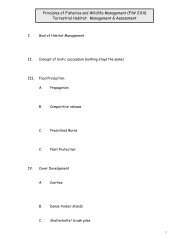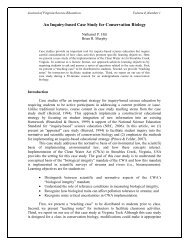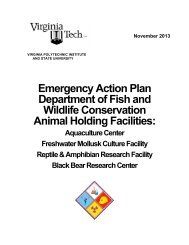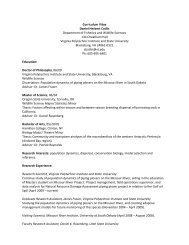An International Journal of Ecology, Evolution and Environment
An International Journal of Ecology, Evolution and Environment
An International Journal of Ecology, Evolution and Environment
You also want an ePaper? Increase the reach of your titles
YUMPU automatically turns print PDFs into web optimized ePapers that Google loves.
Am. Midl. Nat. 163:335–350Life History <strong>and</strong> Demographics <strong>of</strong> theEndangered Birdwing Pearlymussel(Lemiox rimosus) (Bivalvia: Unionidae)JESS W. JONES 1U.S. Fish <strong>and</strong> Wildlife Service, Department <strong>of</strong> Fisheries <strong>and</strong> Wildlife Sciences, Virginia Polytechnic Institute <strong>and</strong>State University, Blacksburg 24061RICHARD J. NEVESDepartment <strong>of</strong> Fisheries <strong>and</strong> Wildlife Sciences, Virginia Polytechnic Institute <strong>and</strong> State University, Blacksburg 24061STEVEN A. AHLSTEDTU.S. Geological Survey (Retired), P.O. Box 460, Norris, Tennessee 37828DON HUBBSTennessee Wildlife Resources Agency, P.O. Box 70, Camden 38320ANDMATT JOHNSON, HUA DAN AND BRETT J. K. OSTBYDepartment <strong>of</strong> Fisheries <strong>and</strong> Wildlife Sciences, Virginia Polytechnic Institute <strong>and</strong> State University, Blacksburg 24061ABSTRACT.—The life history <strong>and</strong> population demography <strong>of</strong> the endangered birdwingpearlymussel (Lemiox rimosus) were studied in the Clinch <strong>and</strong> Duck rivers, Tennessee.Reproducing populations <strong>of</strong> L. rimosus now occur only in the Clinch, Duck <strong>and</strong> Powell rivers,as the species is considered extirpated from the remaining portions <strong>of</strong> its range in theTennessee River drainage. Females are long-term winter brooders, typically gravid from Oct.to May. Glochidia are contained in the outer gills <strong>and</strong> are released in association with amantle-lure that resembles a small freshwater snail. Estimated fecundity, based on 8 gravidfemales collected from the Clinch <strong>and</strong> Duck rivers, ranged from 4132 to 58,700 glochidia/mussel. Seven fish species were tested for suitability as hosts for glochidia, <strong>and</strong> five darterspecies were confirmed through induced infestations: Etheostoma blennioides, E. camurum, E.rufilineatum, E. simoterum <strong>and</strong> E. zonale. Ages <strong>of</strong> L. rimosus shells were determined by thinsectioning<strong>and</strong> ranged from 3 to 15 y in both rivers. Shell growth was higher <strong>and</strong> maximumsize greater in males than females in both rivers. Shell growth was greatest in the Duck River.Densities <strong>of</strong> L. rimosus in the Clinch River were maintained at seemingly stable but low levelsranging from 0.07 to 0.27 m 22 from 2004–2007, <strong>and</strong> in the Duck River at similar but higherlevels ranging from 0.6 to 1.0 m 22 from 2004–2006. In the latter river, abundance hasincreased since 1988, likely due to improved minimum flows <strong>and</strong> dissolved oxygen levels inwater releases from a reservoir upstream.INTRODUCTIONThe birdwing pearlymussel (Lemiox rimosus) typically inhabits gravel shoals <strong>of</strong> medium-tolargerivers <strong>of</strong> the Cumberl<strong>and</strong> Plateau <strong>and</strong> Southern Appalachian Mountains (Ortmann,1918). The species was first described by Rafinesque (1831) from the Cumberl<strong>and</strong> River;however, it was never again reported from this river system (Wilson <strong>and</strong> Clark, 1914; USFWS,1984). Hence, the locality information for the original collection record may be erroneous.1 Corresponding author: Telephone: (540) 231-2266; e-mail: Jess_Jones@fws.gov335









